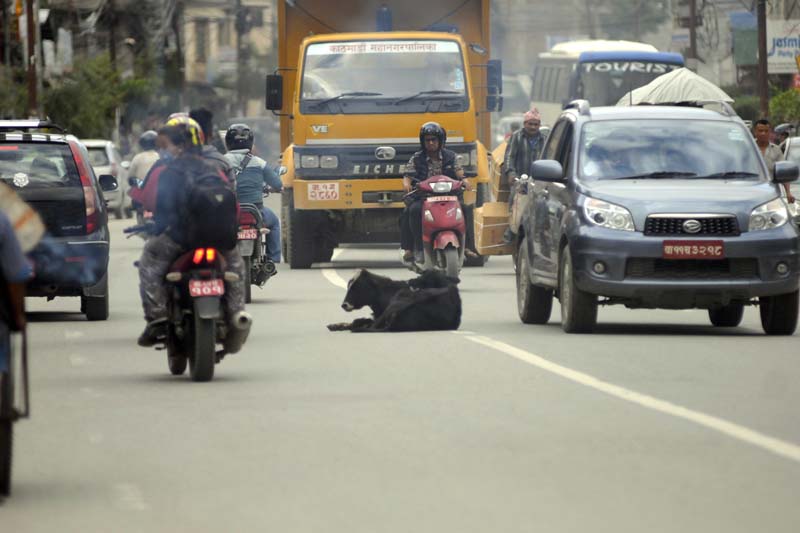The Capital’s Strays
Kathmandu
According to a survey conducted in March by the Humane Society International (HSI) that works on animal protection issues around the world, the population of street dogs in Kathmandu Valley is approximately 22,000.
There are 1,200 road cattle, as per 2016 data of Kathmandu Metropolitan City (KMC).
Stray dogs and road cattle are a regular sighting on Kathmandu streets. Dogs sleeping in the middle of roads, dogs roaming in packs in search of food, limping, diseased dogs, cattle chewing plastic at dumping sites or walking down the streets obstructing traffic are a common sight.
Street animals roam, and many times own, the Valley roads.
Deserted ones
Animal husbandry is still in practice in many parts of Kathmandu Valley. People rear cows for milk. As such, heifers are important to such farmers, while male calves are not which lead them to drive these calves to the roads.
“Male calves are of no use to the farmers as they don’t give milk. So, if a cow gives birth to a male calf, people leave them on the streets. But it is a different case when it comes to heifer calves,” says Dhanapati Sapkota, Chief of Implementation Division at KMC, showing the causes as to how such cattle reach streets.
He gives the reason for such a behaviour. “The usefulness of male calves is more in villages than in cities. They are used to plough the fields. But now even these animals have been replaced by the adoption of modern technology like tractor. In Kathmandu Valley, the utility of these animals is zero, so people leave them on the streets.”
Sapkota adds, “Some owners are so heartless that they even abandon five-day-old male calves on the streets. Even heifers that don’t give milk are chased away.”
The case of stray dogs is no different. But how do man’s best friends end up on the roads?
As per Laxmi Sharma, Chairperson of Kathmandu Animal Treatment (KAT) Centre, “Diseased dogs are abandoned. Even dogs desert their owners for the streets as they are not treated well by the owners. Usually the dogs are not fed and the owners beat them mercilessly.”
Lack of knowledge
Nepal does not have an abattoir. Sharma informs that Nepal is the only country in the world without a humane abattoir, which is a concern with regards to animal suffering.
“Animals are transported in packed trucks, these animals are tied to the vehicle through their noses and travel without food and water. After arrival, they are sledgehammered,” she says.
“If Nepal wants to flourish in the business of livestock, then they must make legal provisions for the same.”
Most people do not know about animal rights and “are not aware about the sufferings of the animals and not ready to accept the idea that animals also suffer like humans” according to Sharma.
Teku is the designated place for butchering and slaughtering animals (mainly buffaloes) in the Capital . “It is not exactly a manageable slaughterhouse. It is an open space for slaughtering animals,” Shrestha says.
So, the government is also making a “proper slaughterhouse to provide meat to the whole nation. The project will be running within three years in association of the government and local administration. Probably, it will be built in Hetaunda or any other place in Tarai region which will supply meat to whole nation”.






